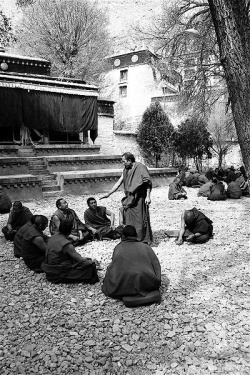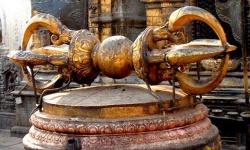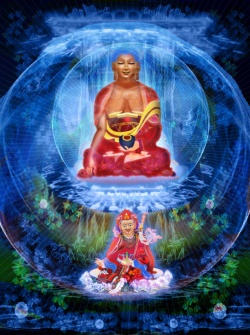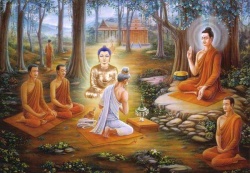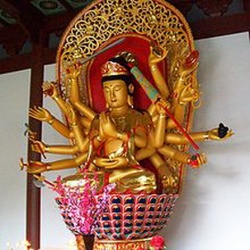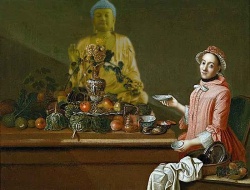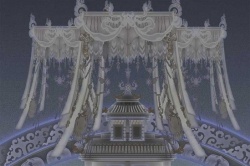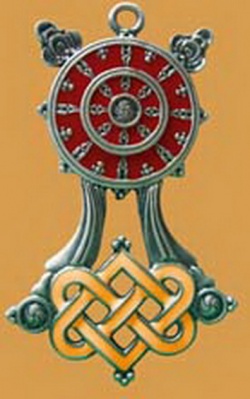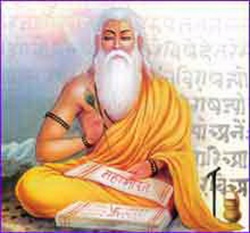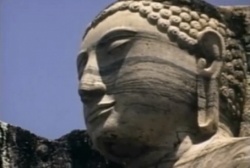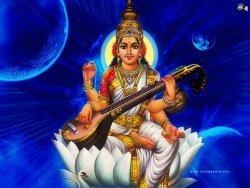Difference between revisions of "Mūlasarvāstivāda School in Japan"
m (Text replacement - "[[[" to "([[") |
|||
| Line 208: | Line 208: | ||
| − | [[Taihin hōgo]] [[對賓法語]] | + | [[Taihin hōgo]] [[對賓法語]] ([[Dharma talk]] to a guest] takes the [[form]] of a {{Wiki|catechism}} and is written not in [[kanbun]] [[漢文]] (or “Classical {{Wiki|Chinese}}”) as one might expect, but in what [[Miyasaka]] Yūshō (1958) refers to as [[kanagaki]] [[仮名書き]](a mix of Sino-Japanese closely approximating the colloquial [[language]]). |
[[Miyasaka]] tells us that this is one of the most outstanding examples in the [[Esoteric]] [[tradition]] of [[kana dharma talks]] ([[仮名法語]]) from the middle of the {{Wiki|Tokugawa}} {{Wiki|era}}. | [[Miyasaka]] tells us that this is one of the most outstanding examples in the [[Esoteric]] [[tradition]] of [[kana dharma talks]] ([[仮名法語]]) from the middle of the {{Wiki|Tokugawa}} {{Wiki|era}}. | ||
| Line 216: | Line 216: | ||
Our text begins with a question and Gakunyo’s response: | Our text begins with a question and Gakunyo’s response: | ||
| − | A pious man came and asked saying, “Recently I have heard that the [[Master]] bestows the [[Bodhisattva precepts]] regardless of lay or [[monastic]] [{{Wiki|status}}] according to [[spiritual]] ability, and also confers | + | A pious man came and asked saying, “Recently I have heard that the [[Master]] bestows the [[Bodhisattva precepts]] regardless of lay or [[monastic]] [{{Wiki|status}}] according to [[spiritual]] ability, and also confers ([[ritual]] [[vows]] for] [[rebirth]] in [[Tuṣita]], also exhorts [[rebirth]] in [[Sukhāvatī]], sometimes also discusses the [[doctrine]] of [[attainment of Buddhahood]] in one’s {{Wiki|present}} [[body]], down to [[mantras]], [[nenbutsu]], and [[daimoku]], instructs according to people’s preferences—I consider this to be extremely imprudent.” |
| Line 262: | Line 262: | ||
In the main text [[Tainin]] responds to the questions of his guest and refutes nine points made by [[Shunpō Myōzui]] [[俊鳳妙瑞]] (1714–1787) (not to be confused with [[Gakunyo’s]] [[teacher]] [[Myōzui]] [[妙瑞]]). | In the main text [[Tainin]] responds to the questions of his guest and refutes nine points made by [[Shunpō Myōzui]] [[俊鳳妙瑞]] (1714–1787) (not to be confused with [[Gakunyo’s]] [[teacher]] [[Myōzui]] [[妙瑞]]). | ||
| − | Note, however, that in this text of 1785 Tainin attacks [[Mitsumon]] [[密門]] (a fellow [[student]] of [[Gakunyo]] under [[Myōzui]]), who had previously refuted [[Tainin’s]] [[interpretation]] of a passage in the [[Fanwang jing]] [[梵網經]] | + | Note, however, that in this text of 1785 Tainin attacks [[Mitsumon]] [[密門]] (a fellow [[student]] of [[Gakunyo]] under [[Myōzui]]), who had previously refuted [[Tainin’s]] [[interpretation]] of a passage in the [[Fanwang jing]] [[梵網經]] ([[Brahmā Net Sūtra]]] ([[Kawaguchi]] 1989, 250, 261–62). |
| Line 270: | Line 270: | ||
The precedent for this is, of course, found in the works of their founder, [[Kūkai]]. | The precedent for this is, of course, found in the works of their founder, [[Kūkai]]. | ||
| − | [[Gakunyo]] writes: Of the threefold {{Wiki|learning}}, [[Shingonshū]] establishes its [[doctrines]] based upon the [[sūtras]], and with regard to the study of [[precepts]] it employs the | + | [[Gakunyo]] writes: Of the threefold {{Wiki|learning}}, [[Shingonshū]] establishes its [[doctrines]] based upon the [[sūtras]], and with regard to the study of [[precepts]] it employs the ([[Mūla]]-] [[sarvāstivāda]] [[Vinaya]]. |
This has been proclaimed by the High [[Patriarch]] in 823. | This has been proclaimed by the High [[Patriarch]] in 823. | ||
| Line 302: | Line 302: | ||
| − | Gakunyo sums up the problem as follows: Obstinately [[clinging]] to the | + | Gakunyo sums up the problem as follows: Obstinately [[clinging]] to the ([[Vinaya]] in] Four Parts and not employing the ([[Mūla]]-][[sarvāstivāda]] ([[Vinaya]]] is not in accordance with the true {{Wiki|tenets}} of the [[Great Teacher]] [i.e., [[Kūkai]]]. |
Would not one say it was a great deviation from the {{Wiki|academic}} {{Wiki|tenets}} of [[Shingon]]? 四分ヲ偏執シ有部ヲ用ヒズンバ大師ノ正宗ニアラズ。真言ノ學則ヲ乱ルトモ 云ンカ。. | Would not one say it was a great deviation from the {{Wiki|academic}} {{Wiki|tenets}} of [[Shingon]]? 四分ヲ偏執シ有部ヲ用ヒズンバ大師ノ正宗ニアラズ。真言ノ學則ヲ乱ルトモ 云ンカ。. | ||
| Line 308: | Line 308: | ||
In a text now appended to [[Gakunyo’s]] [[Shingon ritsugyō mondō, the Geishū Fukuōji Gakunyo bandai bukei]] [[藝州福王寺學如畔睇奉啓]] [Proclamation by [[Vandana]]([[Venerable]]) [[Gakunyo]] of [[Fukuōji]], Geishū], addressed to the [[Chief Abbot]] ([[正僧正]]) of [[Shinkōin]] [[真光院]], and dated the fourth day of the twelfth [[moon]], 1759, | In a text now appended to [[Gakunyo’s]] [[Shingon ritsugyō mondō, the Geishū Fukuōji Gakunyo bandai bukei]] [[藝州福王寺學如畔睇奉啓]] [Proclamation by [[Vandana]]([[Venerable]]) [[Gakunyo]] of [[Fukuōji]], Geishū], addressed to the [[Chief Abbot]] ([[正僧正]]) of [[Shinkōin]] [[真光院]], and dated the fourth day of the twelfth [[moon]], 1759, | ||
| − | [[Gakunyo]] states: Henceforth I declare the [[temple]] of [[Fukuō]] a place of study and [[practice]] of the | + | [[Gakunyo]] states: Henceforth I declare the [[temple]] of [[Fukuō]] a place of study and [[practice]] of the ([[Mūla-sarvāstivāda Vinaya]]. [[自今以後福王之寺為有部律学行之處]]。([[Geishū Fukuōji Gakunyo bandai bukei]], 34a10–b1). |
| Line 314: | Line 314: | ||
The [[Exoteric]] [[Masters]] rely on the [[Dharma-guptaka Vinaya]]]; the [[Esoteric School]] studies the [[Mūlasarva astivāda Vinaya]]. 顯家依曇無、密宗學説有. ([[Daranishū shogaku ubu ritsugi]], 1a8–b1; microfilm folio nos. 495–496). | The [[Exoteric]] [[Masters]] rely on the [[Dharma-guptaka Vinaya]]]; the [[Esoteric School]] studies the [[Mūlasarva astivāda Vinaya]]. 顯家依曇無、密宗學説有. ([[Daranishū shogaku ubu ritsugi]], 1a8–b1; microfilm folio nos. 495–496). | ||
| − | Ryūkai also asks: The various schools rely on the | + | Ryūkai also asks: The various schools rely on the ([[Vinaya]] in] Four Parts; why may the [[Shingon School]] alone [use the [[Vinaya]] of] another [[sect]]? Although recent {{Wiki|adherents}} lecture on the ([[Mūla-sarvāstivāda Vinaya]], and discuss the standards of the [[Esoteric School]], what is the textual authority [for this]? 諸宗依四分、獨眞言宗奚得他部。然近世徒講有部律談密宗軌、有何典據。 ([[Daranishū shogaku ubu ritsugi]], 2b6–7; microfilm folio no. 497) |
To this Ryūkai’s answer is straightforward: [[Kūkai’s]] Catalogue and the petition to the [[emperor]] in which the [[Vinaya]] of the [[Mūlasarvāstivādins]] is declared to be an {{Wiki|academic}} [[tenet]] of the [[Esoteric]] [[tradition]] (答。祕密三學録、及大政官符、明 以有部之調伏、為密宗之學則; [[Daranishū shogaku ubu ritsugi]], 2b7–8; microfilm folio no. 497). | To this Ryūkai’s answer is straightforward: [[Kūkai’s]] Catalogue and the petition to the [[emperor]] in which the [[Vinaya]] of the [[Mūlasarvāstivādins]] is declared to be an {{Wiki|academic}} [[tenet]] of the [[Esoteric]] [[tradition]] (答。祕密三學録、及大政官符、明 以有部之調伏、為密宗之學則; [[Daranishū shogaku ubu ritsugi]], 2b7–8; microfilm folio no. 497). | ||
| Line 398: | Line 398: | ||
At meal times [the Elder] must observe the pace of the junior [[monks]]. | At meal times [the Elder] must observe the pace of the junior [[monks]]. | ||
| − | He must] eat slowly; he should not eat too fast lest he prevent the junior [[monks]] from satisfying themselves | + | He must] eat slowly; he should not eat too fast lest he prevent the junior [[monks]] from satisfying themselves ([[Misshū shogaku uburitsuon shingi]] ([[Reformed Shingon]] 5a4–5: 七者食事須察下座早晩。徐徐而食。不得太速敢令下 座不飽食.] |
| Line 481: | Line 481: | ||
(10) {{Wiki|rules}} for the appointment of officials to distribute various goods 分物等差 (four {{Wiki|rules}}), | (10) {{Wiki|rules}} for the appointment of officials to distribute various goods 分物等差 (four {{Wiki|rules}}), | ||
(11) the pośadha and {{Wiki|recitation}} of the [[precepts]] [[長淨説戒]] (five {{Wiki|rules}}), | (11) the pośadha and {{Wiki|recitation}} of the [[precepts]] [[長淨説戒]] (five {{Wiki|rules}}), | ||
| − | (12) the rains’ [[retreats]] for the five types of [[religious]] [[五衆安居]]110 The text ends with a list of the [[five virtues]] ([[五徳]]), which [[Asai]] (1991, 76) identifies as being from the [[Zhude futian jing]] [[諸徳福田經]] | + | (12) the rains’ [[retreats]] for the five types of [[religious]] [[五衆安居]]110 The text ends with a list of the [[five virtues]] ([[五徳]]), which [[Asai]] (1991, 76) identifies as being from the [[Zhude futian jing]] [[諸徳福田經]] ([[Sūtra]] on [[virtues]] as a [[field of merit]]] (t 683), and the ten sets of {{Wiki|learning}} for novices ([[十數]]) from the [[Mahāsāṃghika Vinaya]]. (ten {{Wiki|rules}}), ( |
13) the two types of [[pravāraṇā]] [[二部隨意]] (three {{Wiki|rules}}), and (14) miscellaneous [[要須雜行]](twenty-six {{Wiki|rules}}). | 13) the two types of [[pravāraṇā]] [[二部隨意]] (three {{Wiki|rules}}), and (14) miscellaneous [[要須雜行]](twenty-six {{Wiki|rules}}). | ||
Revision as of 04:02, 4 April 2016
Mūlasarvāstivāda School in Japan
by
Vira Avalokita, Sthera
In the Tokugawa period two Shingon scholar-monks—Myōzui 妙瑞 (1696–1764) and Gakunyo 學如 (1716–1773)—turned their attention back to Kūkai, the founder of their tradition.
When Myōzui and Gakunyo realised that their lineage had been ignoring Kūkai’s instructions on monastic discipline for nearly one thousand years, these monks advocated a revival of Kūkai’s monastic curriculum.
The present paper is an attempt to survey the sources for this revival movement, tracing the Mūlasarvāstivāda tradition down through the Tokugawa and Meiji periods and beyond, reaching the somewhat unexpected conclusion that this monastic tradition is still alive in present-day Japan.
The rhetoric of Buddhist decline or degeneration first appears in Tokugawa period clerical circles in the form of several monastic reform or restoration movements such as Jizan Myōryū’s 慈山妙立 (1637–1690) Anraku ritsu 安樂律 within Tendai,
Jiun Onkō’s 慈雲飮光 (1718–1804) Shōbō ritsu 正法律 within Shingon, the Shingon ritsu 眞言律 of Jōgon 淨嚴 (1639–1702), Menzan Zuihō 面 山瑞方 (1683–1769) (see Riggs 2002) and Banjin Dōtan’s 萬仭道坦 (1698–1775)
Zen Precepts 禪戒, and the Koki undō 古規運動 in Sōtōshū 曹洞宗.
These movements, unfortunately, have received very little attention outside of Japan, and even there it would seem that the surface has only barely been scratched.
There was, however, another movement during this period which seems to have emerged not explicitly as a reaction to degeneration or moral corruption (although this may be to some degree implicit), but from the recognition that for nigh on a thousand years the last words of the school’s founder, Kūkai (774–835), had been ignored.
Kūkai compiled a curriculum of texts to be studied by his lineage.
These texts followed the traditional categories of Sūtra, Vinaya, and Abhidharma.
Vinaya in Japan—and most of East Asia, for that matter—has usually referred to the Vinaya in Four Parts 四分律 (Jp. shibun ritsu, Ch. sifen lü) or Dharmaguptaka Vinaya. Kūkai, however, does not list this monastic code; instead, for reasons which have yet to be satisfactorily addressed, he lists the Mūlasarvāstivāda Vinaya (MSV) (Jp.Konpon-setsuissaiubu binaya, Ch.
Genbenshuoyiqieyoubu pinaiye 根本説一切有部毘奈耶).
This, however, seems to have been forgotten or ignored until the Tokugawa period. [On Kūkai’s curriculum see notes 67 & 68 below.
This has been noted by, among others, Groner 1990 (285, note 45), and Abé 1999 (54 and note 141; Abé’s yūbu 有部 should be corrected to ubu, and his Sarvāstivāda—variously misspelt—actually refers to the Mūlasarvāstivāda;
note that the Japanese tradition often refers to both the Sarvāstivāda and Mūlasarvāstivāda simply as ubu 有部).
In addition to the sources cited by Groner, see also Ueda Tenzui 1932, and Shaku Keihō 1939a on the possible reasons for Kūkai’s inclusion of this text]
I have organized the discussion around the life and works of four central figures: Myōzui 妙瑞 (1696–1764), Gakunyo 學如 (1716–1773), Eigon 榮嚴 (1814–1900), and Shaku Unshō 釋雲照 (1827–1909).7 Myōzui was a Shingon monk and the abbot of Entsūji 圓通寺 on Kōyasan.
He appears to have been one of the first to advocate the study of the Mūlasarvāstivāda Vinaya, and compiled a number of Vinaya digests during his itinerant lecturing schedule.
In addition to these texts, he also kept a series of diaries that offer detailed insights into the daily schedule of a traveling preacher monk lecturing on the Lotus Sūtra in Tokugawa Japan.
Gakunyo was a disciple of Myōzui at Entsūji, and seems to have been highly vocal in asserting that the Shingon lineage should use the Mūlasarvāstivāda Vinaya.
Upon his return to Aki 安藝 (modern-day Hiroshima), he officially declared Fukuōji 福王寺 to be a Mūlasarvā-stivāda Vinaya training temple, and seems to have been the first to advocate sole use of the Mūlasarvāstivāda Vinaya over the Dharmaguptaka Vinaya.
Eigon spanned the Tokugawa and Meiji periods, and would seem to be one of the last of the “old school” of Mūlasarvāstivādin monks.
His most important contribution, at least for our purposes, was the compilation of a monastic ordinance.
Finally, his disciple, Shaku Unshō, was a leading figure in Meiji Buddhism, one whose activities were by no means limited to the religious domain, but also featured prominently in political and educational circles.
On Unshō and education see, among others, Saitō 1968. Note that the literature on Unshō, unlike that on other Japanese Mūlasarvāstivādin monks, is extensive.]; [ A full study of the impact of the Mūlasarvāstivāda Vinaya in China is an urgent desideratum.
In this connection, the detailed colophon appended to fascicle one of Yijing’s translation of the Mūlasarvāstivāda Vinaya Nidāna (Taishō [hereafter t] 1452, 418b–419b) is of particular import.
The colophon provides detailed information on names, titles, countries of origin (including, among others, Middle India 中天竺國, East India 東天竺國, Kaśmīra 迦濕彌羅國, and Tukhāra 吐火羅) and duties performed by those who participated in the translation process.
It also includes details on a number of Chinese literati also present and involved in the final redaction.
For the Mūlasarvāstivāda Vinaya’s possible influences on the development of Chinese literature, see Hirata 1995.]
In fact, this is—as far as I know—the only record of a living, thriving Mūlasarvāstivādin tradition that is precisely locatable in time and space in the history of East Asian Buddhism.
It is, moreover, a record that sheds light on an often overlooked corner in the history of Japanese Buddhism, and appears to stand in stark contrast to the general view of Tokugawa Buddhism as being degenerate, or morally corrupt.
The rich commentarial tradition suggests that these texts were the object of intense academic study.
In addition, however, a number of texts such as local monastic ordinances were also produced, and these point to the implementation of the Mūlasarvāstivāda Vinaya in the daily life of these monastic communities.
This, of course, is of particular interest as it tells us how these communities may have operated and functioned in early Tokugawa Japan.
The appearance in these indigenous texts of modified rules such as those on lending money on interest, and other commercial activities, suggest the possibility that such activities were more than merely textual ideals, that they were in all probability actually realized.11
It is too early to know whether or not our record is verifiable from other historical sources, but—as we will see—the reworking of the massive Mūlasarvāstivāda Vinaya into a series of manageable handbooks appropriate to the local customs and environs presents the very real possibility that this was at least attempted.
Moreover, a number of the insights offered are pertinent not only to the history of Buddhism in East Asia, but also suggest answers to questions in the field of Indian Buddhism—questions such as the relationship between the Sarvāstivāda and the Mūlasarvāstivāda.
Myōzui (1696–1764)
One of the foremost figures in the Mūlasarvāstivāda Vinaya revival in Tokugawa Japan was the Shingon monk Myōzui, styled Eshin-bō 惠深房.
Myōzui was born in Mino-gun 三野群, Sanuki 讃岐, into the Tabuchi 田淵 family.
At the age of twelve he received the tonsure and dyed robe from Eryō 慧了 at Itokuin 威徳院, and ascended Mt. Kōya to reside in Hōgon’in 寶嚴院. He later moved to the Shōkyokunanbō at Osaka 大坂生玉南坊, then Nyoirinji 如意輪寺, and various other temples.
He studied Chūin-ryū 中院流 and Saiin-ryū 西院流 under Eidō 英同 at Hōshōin 寶性院, An-ryū 安流 under Ihō 維寶 (1687–1747) at Shakamon’in 釋迦文院, Kojima-ryū 小嶋流 under Kyōei 教榮 at Minami’in 南院, and Kan-ryū 勸流 under Kenga 賢賀 (1684–1769) of Tōji 東寺.
At age fortyeight, in the seventh moon of 1743, he entered Shinbessho 眞別處, and apparently took over the abbotship of Entsūji on the first day of the ninth moon (九月一日辰時進具繼圓通), living there for eighteen years.His passing in his sixtyninth year is recorded on the fifth day of the twelfth moon, 1764. During his lifetime Myōzui composed more than two hundred fascicles of texts.
His biography tells us that from the spring of his thirtieth year until his autumnal years, he traveled around the country teaching and delivering countless lectures.
During the course of his lectures Myōzui also compiled at least the following six diaries (Ueda Tenzui 1939a, 2–3):
The history of printing on Kōyasan would seem to be worth investigation.
Since the Kamakura period, Kōyasan was, alongside Kyoto and Nara, one of the most active publishing districts for Buddhist books in Japan (see the Introduction by Wada Mankichi 和田萬吉 in Nakagawa 1981, 4–5).
On this topic, see the excellent studies by Mizuhara Gyōei 1932 and 1981a.
It would seem that a number of the figures involved in the Mūlasarvāstivāda Vinaya revival, their predecessors, contemporaries and successors, also appear in the history of printing on Kōyasan (see Mizuhara 1932, 400–64; and during the Meiji, 467ff.).
On a number of printing blocks stored at Entsūji, see Mizuhara 1932, 568–69; Mizuhara mentions two damaged sets (板木二括) of Vinaya printing blocks there.
See also the graphs plotting the publishing activities on Kōyasan from the Heian to Edo periods, particularly the staggering increase during the Momoyama and Edo periods (Mizuhara 1932, 751–53).
Note also Mizuhara’s separate study (1931) of the various editions of the Chinese Buddhist canon preserved at Kōyasan.]
In addition to his diaries, Myōzui compiled two volumes of a digest on the Mūlasarvāstivāda Vinaya, volumes which appear to exist only as unpublished manuscripts.
Again we are indebted to Ueda (1939a) for providing us with the chapter colophons, the only parts to which we have access.
The text is known as Ubu hyōmoku 有部標目 [The (Mūla-sarvāstivāda Vinaya topical table],31 and although the exact content is not known,
Ueda tells us that it is a catalogue of the contents of the enormous Mūlasarvāstivāda Vinaya.
It was apparently composed between 1747 to 1748, the period coinciding with Myōzui’s second diary written during his travels around Sanuki, and, it would seem from the colophons, also around Yamato 大和 (Washū 和州).
There are eight colophons, one for each of the Mūlasar-vāstivāda Vinaya texts read by Myōzui on his travels.
These colophons, in fact, also provide further details of Myōzui’s itinerary which would, if we had access to them, presumably be available in the diaries themselves.
At least an approximate idea of the length of Myōzui’s Mūlasarvāstivāda Vinaya compendium, and to a lesser degree its content, however, may be gleaned from the colophons.
The last colophon given by Ueda is also telling. The text listed is the Sarvāstivāda Vinaya *Mātṛkā (10 fasc.) and this text is, according to its title, and according to most modern Vinaya scholarship, not Mūlasarvāstivādin at all but Sarvāstivādin.44
Why would Myōzui have chosen a Sarvāstivādin text to accompany his Mūlasarvāstivādin corpus?
If his intent was comparative Vinaya work, then surely he would have chosen the Sarvāstivāda Vinaya (Ch. Shisong lü 十誦律) itself, and not this shorter “ancillary” text. 45
In fact, although by no means conclusive, the addition of this text would at least suggest that Myōzui and the other Japanese Mūlasarvāstivādin monks may have considered it to be Mūlasarvāstivādin, and not Sarvāstivādin.
If it is Mūlasarvāstivādin, and in fact there are other indications that it might well be so, this would have wide implications for the dating of the Mūlasarvāstivāda Vinaya, and the relative chronology of the entire Sarvāstivāda and Mūlasarvāstivāda Vinaya corpora (see Clarke 2004).
A cursory examination of this text would suggest that it contains many sections which bear a striking resemblance to the Uttaragrantha as preserved in Tibetan.
In fact, it is beginning to appear that Sapoduobu pini modeleqie 薩婆多部毘尼摩得勒伽 (T 1441) may even be an early translation of parts of the Uttaragrantha, some three hundred years earlier than Yijing’s incomplete translation of the Mūlasarvāstivāda Vinaya corpus.
This, however, will have to be addressed at a later date.
(1) Kūkai implemented a curriculum of Sūtra, Vinaya, and Abhidharma texts, and the Vinaya specified was none other than the Mūlasarvāstivāda Vinaya.
Accordingly, adherents of the Shingon tradition should follow this Vinaya and not the Dharmaguptaka Vinaya.
- 2a3–6:
- 有部律ハ小乘ナレドモ高祖ハ三學ノ録ニ真言宗諸學ト題シタマヘハ
- 真言宗ノ行フ有部ハ密教ト成テ彼ノ小乘人ノ有部律ノ意ト又四分律宗ノ律
- 行ノ意ト雲泥ノ相違アルコトナリ。
- 6a8–9:
- 此中律宗ハ四分律ヲ以テ立タリ。真言宗ハ有部律ヲ用。
- 13a6–7:
- 大師モ三學ノ録ニ有部律ヲ列テ真言ノ行ナルコトヲ示シ玉ヒ。
(2) Kūkai himself was initiated under, and implemented, the Mūlasarvāstivāda Vinaya tradition, as was his disciple Engyō 圓行.
This tradition, however, was later discontinued.
(3) The eight patriarchs of the Shingon tradition (starting with Nāgārjuna 龍猛) were ordained as Mūlasarvāstivādins, and thus Kūkai was following the precedent of the other patriarchs (he being the eighth).
- 10a1–2:
- サレドモ元祖龍猛有部ヲ行シタマヒ代々祖師此ニ倣テ有部律ヲ本
- サレドモ元祖龍猛有部ヲ行シタマヒ代々祖師此ニ倣テ有部律ヲ本
學トシタマヘリ。
(4) The three areas of learning are like a tripod; all three are essential to its stability Furthermore, as the Vinaya is the most subject to lapse, special training centers should be established in order to resurrect and maintain the Vinaya tradition.
Unlike Risshū, which is founded upon the Dharmaguptaka Vinaya tradition of Daoxuan 道宣 (596–667) and Jianzhen 鑑眞(Jp. Ganjin) (683–763), Shingon is based on a Sūtra.
- 12a3–4 (cf. 14a9):
- 戒定慧ノ三學ハ鼎ノ三足ニ喩ヘテ一モ闕ヘカラザルコト
- 戒定慧ノ三學ハ鼎ノ三足ニ喩ヘテ一モ闕ヘカラザルコト
ハ大小顯密佛法ノ通軌ナリ。必ズ具足スベシ。
(5) Monks of the Shingon tradition should, like the other schools, accept official appointments, and wear silk robes, and so forth.
Taihin hōgo 對賓法語 (Dharma talk to a guest] takes the form of a catechism and is written not in kanbun 漢文 (or “Classical Chinese”) as one might expect, but in what Miyasaka Yūshō (1958) refers to as kanagaki 仮名書き(a mix of Sino-Japanese closely approximating the colloquial language).
Miyasaka tells us that this is one of the most outstanding examples in the Esoteric tradition of kana dharma talks (仮名法語) from the middle of the Tokugawa era.
It seems that the move from elitist literary forms such as Classical Chinese was perhaps an attempt to take the dharma to the masses, as opposed to keeping it solely as the purview of learned scholar monks.
Our text begins with a question and Gakunyo’s response:
A pious man came and asked saying, “Recently I have heard that the Master bestows the Bodhisattva precepts regardless of lay or monastic [[[Wikipedia:status|status]]] according to spiritual ability, and also confers (ritual vows for] rebirth in Tuṣita, also exhorts rebirth in Sukhāvatī, sometimes also discusses the doctrine of attainment of Buddhahood in one’s present body, down to mantras, nenbutsu, and daimoku, instructs according to people’s preferences—I consider this to be extremely imprudent.”
- 信士來り問て曰、頃日承り候に、師は在家出家を擇ばず、機に隨て菩薩戒を
- 授け、又都率往生をも授け、又極樂往生をも勸め、或は即身成佛の旨をも談
- じ、眞言念佛題目に至る迄、人の好みの通りに授け給ふよし、此事甚だ輕く
- 存候。59
The question continues noting that other sects advocate a single practice, and finally concludes by asking for a response.
Gakunyo responds by asking why it is that the Tathāgata expounded 84,000 teachings, and then goes on to explain that the Tathāgata gives medicines in accordance with the illness (應病與藥), and that if there are four hundred and four types of illnesses it is only appropriate that there be an equal number of medicines.
There are a number of points that should be made here, and these may bear fruitful investigation.
The first is the general genre of kana hōgo, and how the text by Gakunyo compares with the works of monks from other schools more renowned for this genre: the Pure Land, Nichiren, and Zen schools.
The similarities to this in, for instance, Vinaya Master Tainin’s 諦忍 (1705–1786) Shishirin manpitsu 獅子林漫筆 [Random writings at the Lion’s Grove] are perhaps worth noting.
Again this is another text which seems to have attracted very little scholarly attention, but what attention it has attracted—the keen eye of Kawaguchi Kōfū—is most certainly of the highest calibre.
The preface of the text includes the following (Kawaguchi 1990, 161–62):
Recently in the grove rain has been incessant, and the four directions are without any sign of people. Unexpectedly, a guest came and pulling out a text from his cloak stated, “
This is a new release. It comes from the religious in Kyoto.
That is, it is called Ryakujutsu Daijōkai gi [Abridged exposition on the meaning of the precepts of the Great Vehicle], expounded by Shunpō Myōzui of Kōmyōji, Rakuhoku.
Although we read this, there are many points which we do not understand. Accordingly, I wish to ask the Master about it.”
- 頃日林下雨頻ニシテ四望闃寂タリ。偶客来テ懐中ヨリ一書ヲ出シテ曰。是新
- 刻ナリ。京都法類ヨリ到来ス。則チ洛北祥光寺俊鳳妙瑞ノ所述ニシテ名ヲ略
- 述大乗戒義ト号ス。吾儕読之トイヘドモ通ゼザルコト通多シ。63 因テ師ニ就イ
- テ問ント欲ス。
In the main text Tainin responds to the questions of his guest and refutes nine points made by Shunpō Myōzui 俊鳳妙瑞 (1714–1787) (not to be confused with Gakunyo’s teacher Myōzui 妙瑞).
Note, however, that in this text of 1785 Tainin attacks Mitsumon 密門 (a fellow student of Gakunyo under Myōzui), who had previously refuted Tainin’s interpretation of a passage in the Fanwang jing 梵網經 (Brahmā Net Sūtra] (Kawaguchi 1989, 250, 261–62).
One of the major tenets of this text is that Shingonshū should observe the Mūlasarvāstivāda Vinaya, and not the Dharmaguptaka Vinaya.
The precedent for this is, of course, found in the works of their founder, Kūkai.
Gakunyo writes: Of the threefold learning, Shingonshū establishes its doctrines based upon the sūtras, and with regard to the study of precepts it employs the (Mūla-] sarvāstivāda Vinaya.
This has been proclaimed by the High Patriarch in 823.
- 真言宗ハ三學ノ中ニ於テ経ニ依テ宗ヲ立テ、戒學ニ於テハ有部律ヲ用ユ、是
- ハ弘仁十四年高祖奏聞ニ達シ。 (Shingon ritsugyō mondō, 1b4–6)
Gakunyo, who was later to declare his temple at Fukuōji a Mūlasarvāstivāda monastery, was clearly not impressed by the fact that Kūkai’s curriculum was not being followed.
Gakunyo’s reaction, however, was to draw severe criticism, and a debate soon ensued over the exact significance of Kūkai’s inclusion of the Mūlasarvāstivāda Vinaya in his Catalogue.
The dispute was about which Vinaya or mainstream monastic code was to be followed, and not a question of Mahāyāna Bodhisattva precepts.
This is clear from Gakunyo’s answer:
With regard to the Vinaya there are the Greater and Lesser. The Vinaya of the Great Vehicle is not that which is now under discussion.
The Vinayas of the Lesser Vehicle are the five Vinayas being the (Mahā-)sāṃghika Vinaya, (Mūla-) sarvāstivāda, Vinaya in Four Parts (= Dharmaguptaka), Vinaya in Five Parts (= Mahīśāsaka), and Vinaya in Ten Recitations (= Sarvāstivāda).
- 律ニハ大小アリ。大乘律ハ今ノ所論ニアラズ。小乘律ハ僧祇律、有部、四分
- 律、五分律、十誦律トテ五部律アリ。 (Shingon ritsugyō mondō, 6a6–8)
Gakunyo sums up the problem as follows: Obstinately clinging to the (Vinaya in] Four Parts and not employing the (Mūla-]sarvāstivāda (Vinaya] is not in accordance with the true tenets of the Great Teacher [i.e., Kūkai].
Would not one say it was a great deviation from the academic tenets of Shingon? 四分ヲ偏執シ有部ヲ用ヒズンバ大師ノ正宗ニアラズ。真言ノ學則ヲ乱ルトモ 云ンカ。.
In a text now appended to Gakunyo’s Shingon ritsugyō mondō, the Geishū Fukuōji Gakunyo bandai bukei 藝州福王寺學如畔睇奉啓 [Proclamation by Vandana(Venerable) Gakunyo of Fukuōji, Geishū], addressed to the Chief Abbot (正僧正) of Shinkōin 真光院, and dated the fourth day of the twelfth moon, 1759,
Gakunyo states: Henceforth I declare the temple of Fukuō a place of study and practice of the (Mūla-sarvāstivāda Vinaya. 自今以後福王之寺為有部律学行之處。(Geishū Fukuōji Gakunyo bandai bukei, 34a10–b1).
The Exoteric Masters rely on the Dharma-guptaka Vinaya]; the Esoteric School studies the Mūlasarva astivāda Vinaya. 顯家依曇無、密宗學説有. (Daranishū shogaku ubu ritsugi, 1a8–b1; microfilm folio nos. 495–496).
Ryūkai also asks: The various schools rely on the (Vinaya in] Four Parts; why may the Shingon School alone [use the Vinaya of] another sect? Although recent adherents lecture on the (Mūla-sarvāstivāda Vinaya, and discuss the standards of the Esoteric School, what is the textual authority [for this]? 諸宗依四分、獨眞言宗奚得他部。然近世徒講有部律談密宗軌、有何典據。 (Daranishū shogaku ubu ritsugi, 2b6–7; microfilm folio no. 497)
To this Ryūkai’s answer is straightforward: Kūkai’s Catalogue and the petition to the emperor in which the Vinaya of the Mūlasarvāstivādins is declared to be an academic tenet of the Esoteric tradition (答。祕密三學録、及大政官符、明 以有部之調伏、為密宗之學則; Daranishū shogaku ubu ritsugi, 2b7–8; microfilm folio no. 497).
Ryūkai then goes on to enumerate the Vinaya texts given in Kūkai’s Catalogue, and explicitly notes that Kūkai lists only Mūla-sarvāstivādin texts, and does not mention the Dharmaguptaka Vinaya at all (根本説一切有部毘奈耶等十二部者、 皆是薩婆多部律也。 此餘不一載四分律等; Daranishū shogaku ubu ritsugi, 4b3–4; microfilm folio no. 499).
The Vinayas, however, are certainly not the only topic of discussion to be found in Ryūkai’s text. There are also discussions of Buddhist sectarian history in India—Mahādeva’s five points of controversy, and the division into two groups: Mahāsāṃghika and Sthavira (大天五事不同分為兩部一大衆部二上座部; Daranishū shogaku ubu ritsugi, 23a4–5; microfilm folio no. 517).
While their discussion may contribute nothing new to our understanding of Indian Buddhist history, they do provide a veritable mine of information concerning premodern Buddhist studies in Japan.
In fact, in what might be more of a reflection of our lack of progress than anything else, we see Ryūkai and his tradition grappling with problems such as the relationship between Sarvāstivāda and Mūlasarvāstivāda—a sticky problem that we are no closer to solving than was Ryūkai.
The colophon to Ryūkai’s text, again, tells us a number of interesting things.
The date and place are given as 1791 (Kansei [[]]3), Spring, third moon, at Matsuoji 松尾寺, Tango 丹後 (written as “Gotan” 後丹).
Furthermore, Ryūkai identifies himself as Bhikṣu Ryūkai Mitsujō (苾芻龍海密乘).
Here again it is interesting to note the use of Yijing’s transcription of Sanskrit bhikṣu (苾芻) as opposed to the more common Dharmaguptaka equivalent (比丘):
Ryūkai would seem to espouse Yijing’s translation of the Mūlasarvāstivāda Vinaya even in his signature (Daranishū shogaku ubu ritsugi, 38a; microfilm folio no. 532).
The last thing to note is that the text which has come down to us was published in 1793 by Heian Shorin 平安書林 of Kyoto.
The publisher, as is often the case, devotes the last leaf to an advertisement of new publications, and it is here that we also learn of another book, hot off the press (新刻), written by one of Ryūkai’s contemporaries, Vinaya Master Tōkū 等空 (1745–1816): Shingonmon shahyōgi 眞言門遮表義.
We also see another book entitled Gokai hen 護戒編 [Collection on observance of precepts] in one volume (Daranishū shogaku ubu ritsugi, microfilm folio no. 533).
Although admittedly most of the other twenty or so titles listed appear to be predominantly Buddhist works, it would certainly seem that our Mūlasarvāstivādin monks were not alone in their emphasis on monastic discipline during the Tokugawa era.
It is also interesting to note the colophon of another text by Jissō, the Himitsu ichijō shira ganzui 秘密一乘尸邏眼髄 [Quintessence of Śīla of the (One Vehicle of the) Esoteric (tradition)] (1767, Meiwa 4).
There Jissō signs his manuscript Bhikṣu Sokuzen Jissō, having vowed to accept all rules of training (誓受一切学処苾芻即染実相), but instead of using the standard Dharmaguptaka transcription of bhikṣu (比丘) Jissō uses the Mūlasarvāstivāda Vinaya transcription, perhaps somewhat provocatively in signing his own name.
This is somewhat ironic in a text which indirectly attacks Gakunyo’s position on the Vinaya in the Shingon tradition.
MSV: the ordination platforms are not limited to ordinations under the Dharmaguptaka Vinaya, but may be ascended and used by ordinands who receive ordination according to other Vinaya texts.
MSV: Kūkai had been ordained in the Dharmaguptaka tradition in his twenty-second year.
It could not, however, be confirmed that he did not receive a new ordination in China.
And even if that was so, there was no problem in practising the Mūlasarvāstivāda Vinaya after being ordained under the Dharmaguptaka Vinaya.
Furthermore, as there is no problem with various schools using the Tōdaiji ordination platform, there is also no problem in receiving the Mūlasarvāstivāda Vinaya ordination there.
MSV: it is clear that Nāgārjuna, Nāgabodhi, Vajrabodhi, and Amoghavajra were all Mūlasarvāstivādin.
Huiguo was originally ordained as a Dharmaguptaka monk, but later as a Mūla-sarvāstivādin. MSV:
there are many precedents for the ordination of those under twenty in China and Japan.
Engyō was ordained under the Mūlasarvāstivāda Vinaya, as were many other disciples.
Three masters and seven witnesses are all that is needed, and this would have been fulfilled at the Tōdaiji ordination platform.
The colophon of the extant recession reveals that Uburitsuon shingi 有部律園清規 text was published in 1884 (Meiji 17) by Wada Daien (?) 和田大圓 of Nishigamo 西賀茂 in Yamashiro山城 (modern-day Kyoto).
After the first three pages in highly cursivized calligraphy, the first of which is the abbrievated title Uburitsuon shingi 有部律園清規, we encounter a full page portrait of Eigon followed by a preface.
The title Uburitsuon shingi 有部律園清規 first section of the text deals with rules governing the “Three Ropes” (sankō 三綱; permanent managerial positions in a monastery) and “Six Threads” (rokki 六紀; temporary administrative positions) Misshū shogaku uburitsuon shingi
4a3–6: 所謂三綱一任永定焉。 綱者如網之有綱。 所以總理紀目也。 三綱一任永定、六紀從大次第巡環五日一交替。紀者是所以別理絲數也..]
The Three Ropes are given as Elder (jōza 上座) (ten rules), Provost (jishu 寺主) (ten rules), and Superintendant (juji 授事) (twenty rules)[
The jishu寺主, which I translate as “provost,” is—as also noted by Asai—in the Indian context the lay patron of the monastery].
Rule seven for the Elder of the monastery, for instance, reads:
At meal times [the Elder] must observe the pace of the junior monks.
He must] eat slowly; he should not eat too fast lest he prevent the junior monks from satisfying themselves (Misshū shogaku uburitsuon shingi (Reformed Shingon 5a4–5: 七者食事須察下座早晩。徐徐而食。不得太速敢令下 座不飽食.]
Similarly the section on the Provost lists rules dealing with monastic book-keeping and the use of perpetuities.
Rule eight, for instance, states that: If one lends [from] the perpetuity to another he must take goods as a pledge, have a contract made and sealed.
Take a good surety, store its documentation in the monastic strong room and guard it well.
Each year at the two seasons one should calculate the interest and record it in full Misshū shogaku uburitsuon shingi 6a68
- 八者貸他無盡財須質物令作券契押 印取好敢保其券疏納僧庫能守護毎年
- 兩季規求其息一一記載. Cf. Asai 1987, 36–37; Gernet 1995, 158–61; Schopen 1994. (Note this was also related to a free micro-finance plan for the poor)
The fourth rule for the Superintendant reads: Every night when about to go to bed, he ought to inspect the precincts of the monastery for calamities such as fire.
Misshū shogaku uburitsuon shingi 7a5: (This is done in Nepal and China still today) 四者毎夜將寢臥時當檢察寺内祝融之難等.]
The six revolving administrative posts are given as Master of Ceremonies (shōdō 唱導) (ten rules), Official in Charge of Offerings (tenku 典供) (twenty rules), Official in Charge of Cleaning (tensō 典掃) (six rules), Manager of theCanon (chizō 知藏) (six rules), Manager of Guests (chikyaku 知客) (ten rules), and Manager of Storehouses (chiko 知庫) (ten rules).
Next follows a section enumerating the thirty Clauses on Ultimate and Conventional Respect (shinzoku raisetsu 眞俗禮節). T
hese include rules on laughing and talking loudly in front of the Buddha [image], not placing regular books on the ground, not handling scrolls with dirty hands,[ Asai interprets this as the left hand (1989, 49, n. 9)], and not discussing politics.[
Misshū shogaku uburitsuon shingi 18b5:
- 四者不得於佛前戲笑及大聲言語; 19a4–6:九者…雖尋常書籍不應輙置地 …又不得不淨手執卷及默唾於指翻轉書牒;19b8–20a1: 十五者不可談論國家治亂世間聲利駒隙難繋虚莫消度.]
The next section introduces one hundred rules of deportment for residence within the monastery (住寺威儀).
The twenty-second rule reminds the reader that the fences and walls have ears, another rule states that one must not [clean] sūtras or images by blowing the dust off with one’s mouth, and another dictates the correct procedure for the disposal in rivers or ponds of paper no longer of any use, but containing Sanskrit or other Buddhist writings.
Misshū shogaku uburitsuon shingi 24b3: 垣壁皆有耳; 25a6–7: 不得口經上塵土像浄準同; 25b7–8: 故紙若有梵書及佛寶之文字者皆取聚一處應投河池清淨之處.]
Next we find a set of admonitions regarding behavior in the Monks Quarters sōdō shinki 僧堂箴規. One rule states:
One may not read non-Buddhist texts in the dormitory.
If it is in order to convert followers of other paths, one may divide the day into three periods studying Buddhist [texts] for two and studying non-Buddhist [texts] for one [of these periods].
9. Misshū shogaku uburitsuon shingi 36b45: 寮中不可讀外典。 儻爲降伏異道日作三時二分學佛 一分學外.
The next section lists rules of deportment for novices (求寂威儀節度).
This is followed by ten articles for a teacher instructing a novice (師教求寂方規), fifty articles for a novice serving his Preceptor (求寂事親教師規儀), and a long series of verses to be recited daily. [111.
Note also the text by Mōkai (foreword dated 1801).
The colophon from the printed edition is dated 1806 (文化三年), and the publisher is given as Zeniya Ribei錢屋利兵衞 of Kōsho Shorin 弘所書林, Sanjōdōri in Kyoto.
Following the prefatory matter, the main text is divided into fourteen chapters, each with a varying number of rules, as follows:
(1) various forms of ordinations 諸衆受戒 (forty rules), (2) formation and dissolution of ecclesiastical boundaries 諸界結解 (thirteen rules), (3) acceptance and division of robe and bowl (i.e., property) 衣鉢守分 (fourteen rules), (4) acceptance and purification of medicinal fruits 藥果受淨 (seven rules), (5) weighing of gold and silver 處量金銀 (four rules), (6) touching fire and taking formal possession 觸火守持 (four rules), (7) rules on bathing 洗浴方法 (four rules), (8) mealtime decorum 食事軌儀 (nine rules), (9) confession of the six classes of offences including pārājikas 説悔六聚 (eight rules), (10) rules for the appointment of officials to distribute various goods 分物等差 (four rules), (11) the pośadha and recitation of the precepts 長淨説戒 (five rules), (12) the rains’ retreats for the five types of religious 五衆安居110 The text ends with a list of the five virtues (五徳), which Asai (1991, 76) identifies as being from the Zhude futian jing 諸徳福田經 (Sūtra on virtues as a field of merit] (t 683), and the ten sets of learning for novices (十數) from the Mahāsāṃghika Vinaya. (ten rules), (
13) the two types of pravāraṇā 二部隨意 (three rules), and (14) miscellaneous 要須雜行(twenty-six rules).
On pārājika penance, see Clarke 2000 and 2006.]
Our text concludes with a postscript (跋), dated 1883 (Meiji 16), by the Lesser Bhikṣu Raifu 小苾芻雷斧 (薫盥稽首謹識), who is presumably Gonda Raifu 權田雷斧 (1846–1934) the second President of Taishō University. 112
Eigon was active as a Mūlasarvāstivāda monk in the closing decades of the Edo period, and the early decades of the Meiji.
A detailed study of Eigon, a monk who would have seen Japan begins to modernize before his very own eyes.
Civilized men are not only originally all brothers of the Four Seas (that is, the whole world), but in Buddhism it is exhorted that:
All men are our Fathers, all women are our Mothers.
In successive rebirths, without fail, we obtain birth from them.
Accordingly, the sentient beings of the Six Paths of transmigration] are all our Fathers and Mothers. 文明の人士にありては固より 四海兄弟な るのみならず、 佛教に於ては一切男 子是我父。一切女人是我母。 我生生無不從之受生。 故六道衆生皆是我父母と 教誡せられたり.
Mūlasarvāstivāda Vinaya revival in the Tokugawa period had ramifications stretching at least as far down as the Meiji, and farther. In 1884, at a Shingonshū congress, Tōji 東寺 was declared to be an official training monastery (根本道場), and it was further agreed that the Mūlasarvāstivāda Vinaya was to be used instead of the Dharmaguptaka Vinaya.
An official protest, however, was lodged by Shōhen 照遍 (1828–1907) who wished to use the Dharmaguptaka Vinaya (Ueda Reijō 1978a, 19).
What eventually became of the Mūlasarvāstivāda Vinaya in Japan, however, to most scholars is not entirely clear.
Since I am a Koyasan Mūlasarvāstivādan monk I think we must still exist.
And so does the Jūzenkai, and the Meijiro Sōen established by Unshō.
Inaya Yūsen, however, certainly suggested that the tradition does exist, in some circles, down to recent times.
As we have seen, Inaya expressed hesitation in regard to a request for ordination in 1987 as he did not feel sufficiently confident in the tradition of the Mūlasarvāstivāda Vinaya.
This led him to consult Gakunyo’s text of 1759 held at Fukuōji.
This, of course, suggests that an Mūlasarvāstivāda is a living, and thriving monastic community of Japanese monks who identified themselves as Mūlasarvāstivādin.
The diaries and digests of Myōzui, for example, provide detailed insights into his lecturing schedule, his own personal reading habits, and his literary activities.
They also suggest an Mūlasarvāstivādin sectarian affiliation of at least one text: the Sarvāstivāda Vinaya *Mātṛkā.
Furthermore, his sermons delivered to large crowds, and his long and arduous travels seem to suggest that at least Myōzui’s Buddhism was anything but degenerate or corrupt.
Similarly, in the works of Gakunyo we see an attempt to revive the long-forgotten Vinaya component of Kūkai’s curriculum—an attempt which drew harsh criticism, and resulted in a debate which seems to have continued down to the Meiji, and perhaps even as late as 1939.
Gakunyo and his contemporaries produced a richly detailed commentarial tradition on the Mūlasarvāstivāda Vinaya, but their contributions were no means limited to exegetical works from the Indian (and by virtue of Yijing, Chinese) tradition.
These Mūlasarvāstivādin monks also produced handbooks, and local monastic ordinances, all of which would seem to suggest that they were attempting to implement the tradition as an integral part of their monastic community.
The same, of course, holds for Eigon and perhaps to a lesser degree for Unshō.
Unshō seems to have been actively engaged in the promotion of the Ten Good Precepts, this is still done at Saifukuji today, perhaps an early “engaged Buddhist,” and as such his achievements are of a slightly different nature to the strictly monastic enterprises of his predecessors.
All in all, judging from the activities of these Mūlasarvāstivādin monks, it would seem that—at least in some circles—Buddhism was very much alive, and the monks very much active in society.
Furthermore, judging from the debates over which Vinaya was to be followed, it would seem that Vinaya was in no Vinaya tradition was, at least to some degree, still known recently.
That the tradition was still alive, however, would also seem to be confirmed by the comments of Asai Kakuchō.
Asai states, with regard to the three Mūlasarvāstivāda training temples, that at Shinbessho the Vinaya tradition and ordinations therein way peripheral, but in fact an integral part of the life of the Shingon monastic communities, whether they identified themselves as Mūlasarvāstivādin or Dharmaguptaka.
Although discussions of Vinaya in the history of Japanese monastic Buddhism usually present only a single voice, a Dharmaguptaka voice, the Mūlasarvāstivāda Vinaya was by no means a non-entity.
Future studies on the role of the Mūlasarvāstivāda Vinaya in Japan will not only enrich our knowledge of Japanese Vinaya studies, but will also offer us a much richer and fuller—and perhaps even balanced—understanding of the history of Japanese Buddhism.

